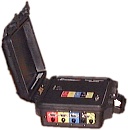|
It was truly a pleasure to test this device. It, in many areas, far exceeded expectations (and their own specifications!) and I am enjoying working with this instrument. There are some distinct features missing from this box being high speed transient capture, genuine delta mode input, and harmonics beyond the 25th - although they do trend inclusively from the fundemental up to the 25th, and the accuracy of this was impressive. But having said this, this little box does have a very neat feature of allowing both 'level trigger' mode as well as 'transition' mode for the capturing of voltage events. I tried it with as little as 1% transition to see if it could handle things - lets just say it was a little bit of information overload - the box handled it well, I didn't! A warning about this above mentioned point; If there are likely to be long periods between downloads then do run the "adaptive thresholds" or the "Fill and Stop". There is limited memory allocated to storing events and waveforms. If asked to capture too often, together with long times between downloads, results in waveforms being captured but then overwritten with subsequent events. Inputs on the unit are 2MW making the use of in-line resistors possible. This is called for as the unit does not cater for larger than 600V input (i.e. no good for 690VACrms systems). I need to be honest and say, owing to the design, I would not stretch the Neutral input beyond about 100V peak. One of the features it has over similar priced competitors is the ability to measure Neutral-Earth voltage. No, I haven't suddenly had a change of heart over N-E but it is important in order to determine a loose Neutral or Earth! I have not seen one instrument in the PowerNode's price range with a similar 5-wire input. The "View Readings" feature contains all the usual voltages and currents, but also kW, kVA, kVAr, Harmonics (2..25), etc. in one neat screen. And, with just one click, the figures are copied to the clipboard for export into any awaiting application that can handle text. Within this screen is also a rather unique figure, and I take full credit for it being there. The growing use of direct-rectified mains powered electronics has made the need to know the peak voltage a norm. This unit displays both positive and negative peak voltages thus alleviating the need to calculate it using a crest factor. Having both peaks removes any guess work as regards any DC component. The Current Sensor inputs are rather clever. The clever part is the 'SmartCTs' comprising of a normal CT with a chip built in to identify the CT, and also program the instrument with a curve providing a ±0.2% accuracy throughout the entire CT range. The unit also offers the use of customer's own CTs as long as there is a 0-1VAC output. Scaling is done with a single figure that workes across all CT inputs, but is adjustable for all ratios from 1..4000A full scale. Added to this, there is an ability to adjust for VT and CT losses. It uses no batteries! Power for an event ride-through is provided by two huge 'supercaps' giving about 15 seconds of CPU time and 45 days of clock back-up. Many ask why so little. Well, if anything, this is a lot! Many devices will have ground to a halt if the power were to fail for merely a second. 15 seconds is more than enough to capture this happening. The unit consumes only 6W of power, a very handy feature when used on secondary power windings on VTs etc. Later models of the recorder have been fitted with a switch mode power supply, but transformer input models are still available if required e.g. where harmonic measurement would be upset if the unit was powered from the measurement point. The single-user version of the software is free (not something someone sees very often!), but you must have Microsoft Excel installed to view graphs and this all installed on a reasonably powerful PC else the time taken to crunch the data becomes annoying. I don't see the PowerNode as competition to the RPM Power Recorder. But it has, at a fair price, brought a genuine introductory / economy power quality recorder into the arena.
© 22.06.03 / 07.09.05 |
 MEASUREMENT TECHNIQUES:
MEASUREMENT TECHNIQUES: It would be unfair to not mention a newcomer to the field, and one I have dubbed as "the poor man's RPM". This is the PowerNode from Enetics. When one sees this little beast you'll realize why I have nicknamed it "the lunchbox".
It would be unfair to not mention a newcomer to the field, and one I have dubbed as "the poor man's RPM". This is the PowerNode from Enetics. When one sees this little beast you'll realize why I have nicknamed it "the lunchbox".